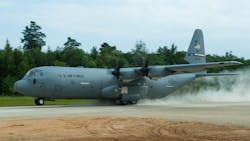L-3 to undertake major avionics and airframe upgrade of Air Force C-130H four-engine turboprop aircraft
WRIGHT-PATTERSON AFB, Ohio – Military aircraft and avionics experts at L-3 Technologies will carry out a major avionics and airframe upgrade of the U.S. Air Force C-130H utility aircraft fleet under terms of a near-half-billion-dollar contract announced this week.
Officials of the Air Force Life Cycle Management Center at Wright-Patterson Air Force Base, Ohio, awarded a $499.6 million contract to the L-3 Platform Integration segment in Waco, Texas, on Tuesday for the C-130H Avionics Modernization Program (AMP) Increment 2 project.
L-3 engineers will upgrade the Air Force C-130H Combat Delivery (CD) fleet of 176 C-130H aircraft, which includes the C-130H1, C-130H2, C-130H2.5, C-130H3, and LC-130H variants of the C-130H four-engine turboprop utility and cargo aircraft.
Stockholders of L-3 Platform Integration parent L-3 Technologies Inc. last April agreed with those of Harris Corp. to merge their companies to create L3 Harris Technologies Inc. to focus on developing differentiated and mission critical solutions for customers around the world.
L-3 will install an electronic prop-control system (EPCS) aboard the Air Force C-130H fleet, improve the aircraft's navigational performance, modernize the cockpit, and address obsolescence issues, while providing improvements to enable the C-130H to interface with new international air traffic management architectures.
story continues below
All C-130H aircraft will receive Automatic Dependent Surveillance-Broadcast (ADS-B) Out and Mode Select (S) Enhanced Surveillance (EHS) capability.
The Lockheed C-130 Hercules is a four-engine turboprop military transport aircraft that has been in service since the mid-1950s. It can use unprepared runways for takeoffs and landings for troop, medevac, and cargo transport aircraft. The aircraft also is for gunship, for airborne assault, search and rescue, scientific research, weather reconnaissance, aerial refueling, maritime patrol, and aerial firefighting.
Compared to the earliest models, the C-130H from the 1960s has updated Allison T56-A-15 turboprops, a redesigned outer wing, and updated avionics. It is in widespread use with the U.S. Air Force and many foreign air forces. The U.S. Coast Guard also uses the HC-130H for long-range search and rescue, drug interdiction, illegal migrant patrols, homeland security, and logistics.
L-3 will install upgrades on the C-130H to meet growing demands of the warfighter, increase system reliability, and ensure the C-130H maintains safe and unrestricted global military and civil airspace access in conduct of its mission.
C-130H AMP Increment 2 upgrades will help the aircraft meet Communication Navigation Surveillance/Air Traffic Management (CNS/ATM) requirements and Air Force Navigational Safety Directives for unrestricted flight in worldwide airspace.
Upgrades also will support improved Required Navigation Performance (RNP) capability; increase reliability; and reduce obsolescence; and address diminishing manufacturing sources (DMS) for replacement parts.
The C-130H AMP Increment 2 project also will develop organic maintenance contracts for commercial off-the-shelf (COTS) and military off-the-shelf (MOTS) items; provide software sustainment; reduce cost; foster competition for operations and support; and allow for future new technologies and capabilities.
L-3 engineers will use an open-systems design to adapt to evolving requirements and threats; facilitate systems reconfiguration and integration; and maintain continued access to cutting-edge technologies and products from several different suppliers.
L-3 avionics experts will choose computer processor types and architecture, software architecture, as well as track the status of all firmware design, development, configuration management, and integration. The company also will choose software processes and common software tools.
In addition, L-3 will carry out a plan to prevent the purchase or use of counterfeit electronic parts, or parts embedded with malicious logic; integrate cyber security; and test electronic components and subsystems to meet MIL-STD-810G environmental requirements.
On this contract L-3 will do the work in Waco, Texas, and should be finished by September 2029. For more information contact L-3 L-3 Platform Integration online at www2.l3t.com/pid, or the Air Force Life Cycle Management Center at www.wpafb.af.mil/aflcmc.
About the Author
John Keller
Editor-in-Chief
John Keller is the Editor-in-Chief, Military & Aerospace Electronics Magazine--provides extensive coverage and analysis of enabling electronics and optoelectronic technologies in military, space and commercial aviation applications. John has been a member of the Military & Aerospace Electronics staff since 1989 and chief editor since 1995.
